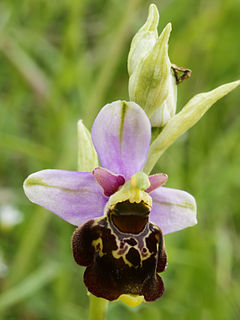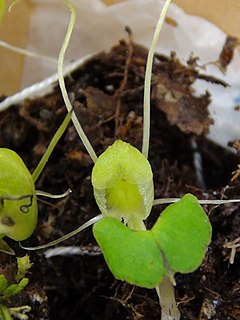
Ophrys apifera, known in Europe as the bee orchid, is a perennial herbaceous plant of the family Orchidaceae. It is remarkable as an example of sexually-deceptive pollination and floral mimicry as well as of a highly-selective and highly evolved plant-pollinator relationship.

The genus Ophrys is a large group of orchids from the alliance Orchis in the subtribe Orchidinae. They are widespread across much of Europe, North Africa, the Canary Islands, and the Middle East as far east as Turkmenistan.
Bee orchid is a common name for several orchids and may refer to:

Ophrys insectifera, the fly orchid, is a species of orchid and the type species of the genus Ophrys. It is remarkable as an example of sexually-deceptive pollination and floral mimicry as well as of a highly-selective and highly evolved plant-pollinator relationship.

Corybas, commonly known as helmet orchids, is a genus of about 120 species of plants in the orchid family, Orchidaceae. Helmet orchids are small, perennial, deciduous herbs and are nearly always terrestrial. They have a single leaf at their base and a single flower on a short stalk, the flower dominated by its large dorsal sepal and labellum. Species of Corybas are found in Australia, New Zealand, New Guinea, Southeast Asia, the Himalayas, southern China, many Pacific islands and a few sub-Antarctic islands.
NVC community CG2 is one of the calcicolous grassland communities in the British National Vegetation Classification system. It is one of three short-sward communities associated with heavy grazing, within the lowland calcicolous grassland group, and is regarded as "typical" chalk grassland.
The Folkestone Downs are an area of chalk downland above Folkestone, where the eastern end of the North Downs escarpment meets the English Channel. Part of the Downs is the Folkestone to Etchinghill Escarpment Site of Special Scientific Interest, designated for its geological and biological interest.

Ophrys sphegodes, commonly known as the early spider-orchid, is a species of sexually-deceptive orchid native to Europe and the Middle East. It is a very varied species with many subspecies recognised.

Ophrys fuciflora is a species of flowering plant in the orchid family. It is widespread across much of Europe from Britain and Spain to Turkey and Romania, plus Libya and the Middle East as far east as Iraq.

Ophrys lunulata, the moon orchid, is a species of orchid native to the islands of Malta and Sicily in the central Mediterranean.
Nematoceras is a genus of orchids, sometimes known as spider orchids, helmet orchids or spidery helmet-orchids, found mainly in New Zealand and its subantarctic islands, with two species on Australia's Macquarie Island. The genus was originally described in 1853 by Joseph Dalton Hooker who published his description in The botany of the Antarctic voyage of H.M. discovery ships Erebus and Terror. II. Flora Novae-Zelandiae. In 2002 David Jones, Mark Clements and Brian Molloy transferred some species of Corybas to Nematoceras but the move has not been accepted by the World Checklist of Selected Plant Families at Royal Botanic Gardens, Kew.
Corybas dienemus, commonly known as the windswept helmet-orchid, is one of two helmet orchids endemic to Australia's subantarctic Macquarie Island, and the first orchid to be found there. It is a relatively small orchid with green flowers with purplish-red markings and was discovered in 1978.

Corybas aconitiflorus, commonly known as the cradle orchid or spurred helmet orchid, is a species of terrestrial orchid endemic to eastern Australia, occurring from south-east Queensland to Tasmania. The small flowers have a hooded appearance as the uppermost sepal hides most of the rest of the flower. It is the type species of the genus Corybas.

Ophrys argolica, the late spider orchid, or Argolian bee-orchid, is a terrestrial species of orchid native to Greece, Italy, Croatia, Cyprus, Turkey, Lebanon and Syria. The epithet "argolica" refers to the Argolia region of Greece, southwest of Athens.

Ophrys × arachnitiformis, the false spider orchid, is an orchid native to Europe. It is apparently a hybrid resulting from a cross between O. fuciflora × O. sphegodes, but has become established in the wild in Britain, France, Germany, parts of Italy, Austria, Switzerland, Hungary, and the former Yugoslavia.

Corybas walliae, commonly known as Zeller's spider orchid, is a species of orchid endemic to New Zealand.

Corybas acuminatus, commonly known as the dancing spider orchid or helmet flower, is a species of terrestrial orchid endemic to New Zealand. It has a triangular, sharply pointed leaf and a small translucent, greenish-white flower with purple markings and with very long sepals. It is found on both the main islands of New Zealand and also some of the off-shore islands.

Corybas cheesemanii, commonly known as Cheesemans spider orchid or spurred helmet orchid, is a species of terrestrial orchid endemic to New Zealand. It is a small orchid with a single pale green, heart-shaped leaf and usually only a single flower variously coloured from maroon to completely white. It usually grows in deep shade, often in deep leaf litter and flowers in autumn and winter.

Corybas confusus, commonly known as the spider orchid is a species of terrestrial orchid endemic to New Zealand. It has a single heart-shaped leaf and a single dark green or light green flower with reddish maroon streaks and blotches and long, thread-like lateral sepals and petals. It grows in highland areas on both main islands.
Corybas cryptanthus, commonly known as the hidden spider orchid or icky, is a species of terrestrial orchid endemic to New Zealand. It has no obvious leaves and the mostly white flower is usually buried in leaf litter. The plant is usually only detected by its fruiting capsule which is borne on a stem which elongates up to 280 mm (10 in) high.













